The Sage of Kettering and I have been on another trip, not to some distant, warm, European setting, but a distinctly chilly Suffolk on a bright early Spring day. Here is my account of our trip to an oft-overlooked corner of England and a dip into the past, focusing on the damage done by the iconoclasts. I am indebted beyond measure to the wonderful Suffolk churches site for inspiration on what to see, and links to pictures.
The first stop was a quick look at a proper windmill, unfortunately under repair, the Post Mill at Saxtead. So much more attractive than the hideous electric-powered windmills that clutter the landscape, sucking up subsidies and slowing down the wind.
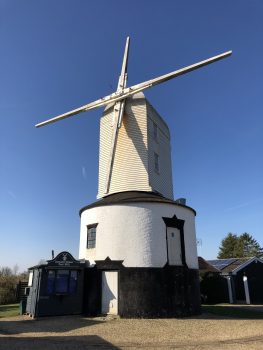
Next stop, the focus of our trip, Framlingham Castle, a series of towers with no inner keep, but it does contain an old Poorhouse. Noted as the place where Mary Tudor was when she was proclaimed Queen after the tumult of Edward VI’s death, and she then went on to make her mark with an unwise marriage and her trademark of barbecuing Bishops.
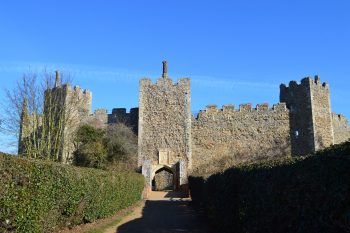
The walls of the castle are impressively high, with an excellent ditch.
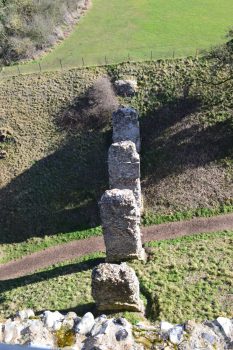
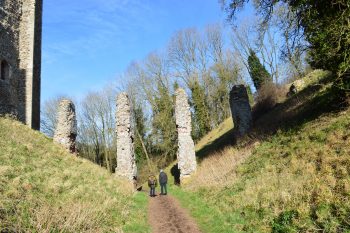
Around the towers, there are Tudor chimneys, allowing some local heating.
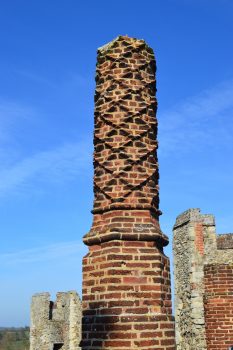
The castle does not have a keep inside it, it is just a wall with a series of towers. The space inside was used to build a poorhouse.
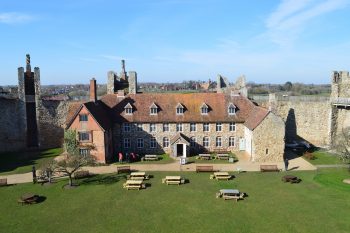
And in the Poorhouse is a local museum, with a fine collection of curious, including this tribute to General Pershing and his Crusaders.
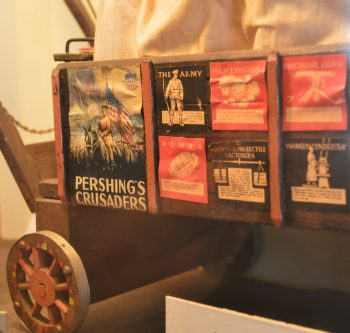
The Sage decided to try out the headgear, it might be useful with canvassing with local elections coming up.
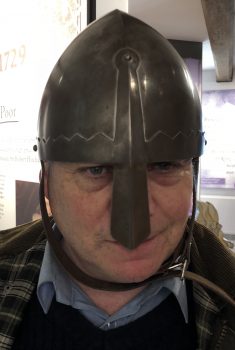
The small town of Framlingham is delightful, with a nice Saturday market. Here is a street, very typical of Suffolk.
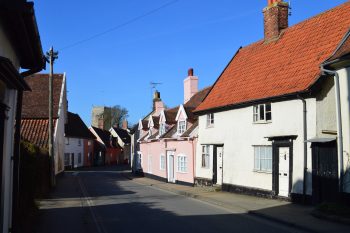
The town’s church has tombs of the Duke of Norfolk’s family, and a bastard son of Henry VIII, as well as a rare surviving 14th Century font. Oddly in this church, they say that the organ is a rare survivor from Cromwell’s vandalism, which is odd as they date it from 1674, and even Tumbledown Dick had lost power by 1660, although he was Great Britain’s second-longest lived Head of State, he did not spend his retirement finishing off what his father had left, and in any event, much of the ‘Popery’ in England’s churches was destroyed under Edward VI, and William Dowsing (a local) finished off most of what remained under Cromwell.
Moving out from Framlingham, we began a tour of a few of the many delightful churches of Suffolk, made of flint rubble. First stop, Dennington, with a delightful lunch spot of a 16th Century pub, with some local cod.

Next door to the church, has some wonderful mediaeval wood carvings, (not destroyed as they were not idolatrous) including England’s only mediaeval carved tortoise.
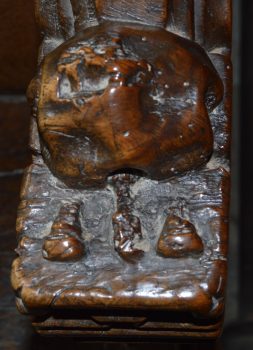
A giraffe, the craftsman presumably did not know that the beast keeps its head up.
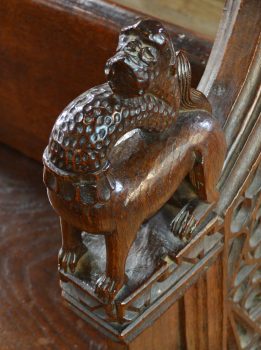
And a sciapod (or monopod), a desert creature attested to by Pliny the Elder and others, who uses his incredibly large foot to hide from the desert sun. Reportedly, the compromise that is a solution to all the quarrels of the Middle East is written on his foot.
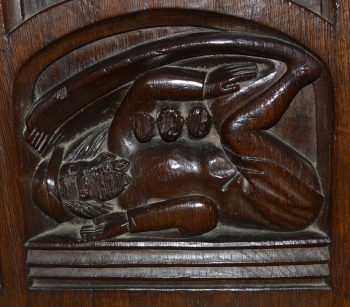
Note that here in Suffolk, the Sixth Commandment is ‘Thou shalt do no murder‘, which crops up again and again.
Moving on to Bramfield.
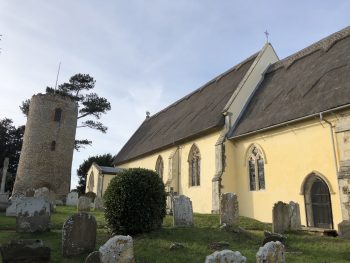
This is one of the many ‘Round Tower‘ churches that dot East Anglia (Norfolk being their redoubt), a wonderfully pretty church, with a detached tower. Notable inside, the tomb of a son of Sir Edward Coke, Lord Chief Justice, and a tombstone telling a story of a lady’s troubled marriage and subsequent happiness, which can’t really be summed up.
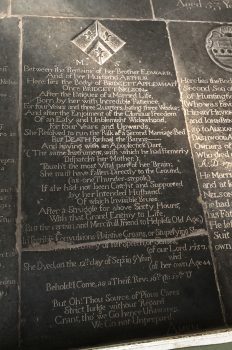
From Bramfield, the nearby hamlet of Thorington, now but a few houses, down a narrow track, another Round Tower church, takes us to one of the most poignant spots, a memorial inside records the deaths of two brothers on consecutive days in May 1918, and perhaps two other brothers more separated in time. The church bell was reportedly donated by Sir Edward Coke, and is still in place.
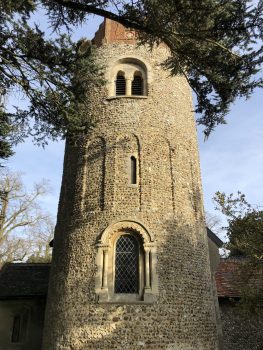
And near the base of the tower, a defaced Angel.
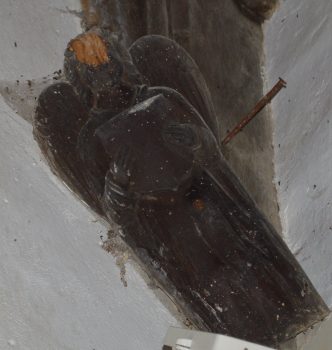
From here, we move on to Wenhaston, where we met no less than the Devil himself. Wenhaston has a ‘Doom’ painting, from around 1490. It was whitewashed over as ‘idolatrous’ c.1550 and left in place, until in 1892, in renovations it was removed, the workmen dumped the timber outside the church as firewood for collection, and it rained overnight, removing the whitewash and revealing the painting concealed for a third of a millennium.
Of the various scenes, there is the Devil and Saint Michael, weighing souls for the Last Judgment.
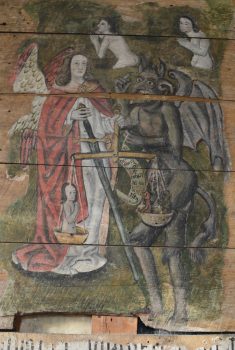
Jesus, looking to me like a caricature of a 1960s Hippy.
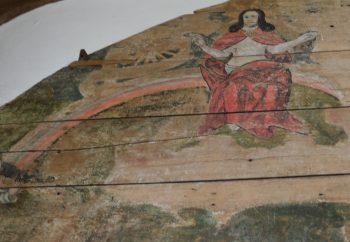
And Demons torturing the Damned, with a behemoth sea monster swallowing them up.
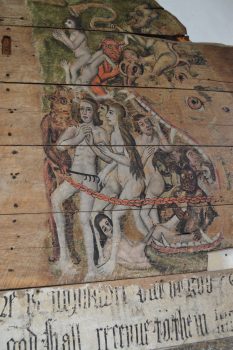
So you can all know what to expect.
From Wenhaston, we stop briefly at the tiny church of Blyford, a small village nearby. Noteworthy is another sad reminder of WW1, a Flanders Cross, the initial grave marker of Captain Day RE, whose remains lie in Belgium. These crosses were taken back to the UK once permanent gravestones were in place. However, Captain Day was from Kent, and his cross ended up here in the post-War chaos, but was kept. A lost reminder of a lost generation.
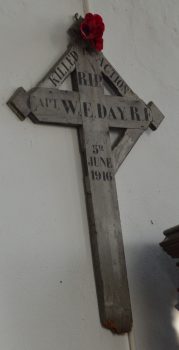
The furthest part of our journey was to the church of Westhall, which is, oddly, nowhere near its village, a good half-mile away across fields and is hidden away down a remote track with a couple of houses around it. Apart from being in the middle of nowhere, it is also odd in that it has two wings, one Norman, the other having been added during the 13th Century.
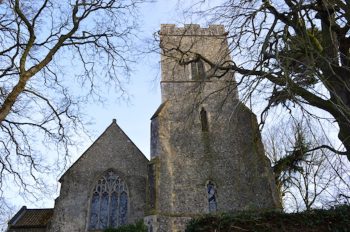
Westhall’s features include a surviving but vandalised mediaeval font, which retains some of its original colour.
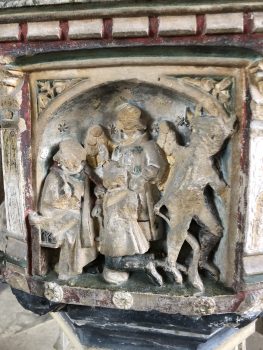
It has some Norman gargoyles in an old, internal arch.
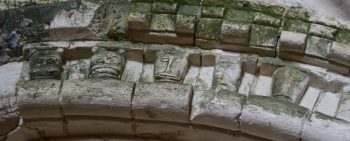
And amongst the wall paintings, there are representations of Moses, with horns, apparently a longstanding trope about him arising from a mis-translation of a description.
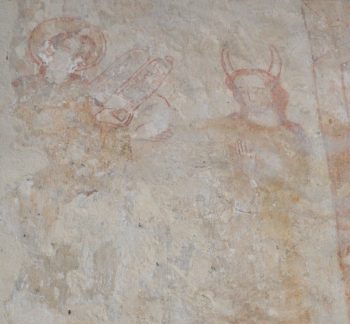
The church has a fine roof.
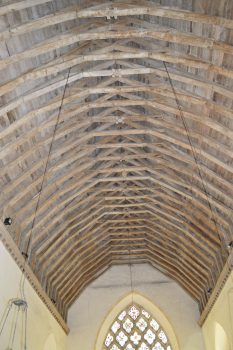
And for some reason, a bishop is up there in on the beams.
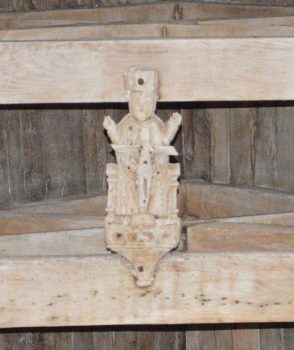
Moving on Blythburgh, a fine church that dominates the marshes it overlooks. In the skies above this church, Joseph Kennedy Jr. and his crew died during WW2 when their drone bomber exploded prematurely. Had he lived, it could well have been him, not JFK, running for office when Eisenhower retired, and the last 50 years of history might well have been somewhat different.
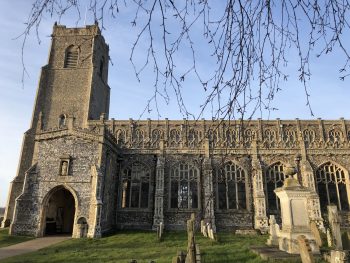
Blythburgh is noted for its many carved angels (Victorian replacements).
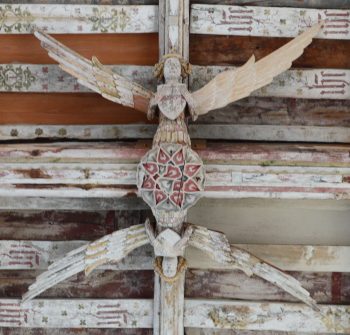
There are also what appear to be Menorahs.
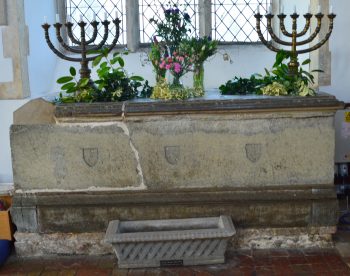
Blyrhburgh also has fine carved bench ends, here is one the Seven Deadly Sins, gluttony.
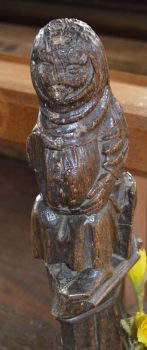
And in this church, a 15th-Century Peter’s Pence box, starting c. 750 AD money collected from these boxes went to Rome.
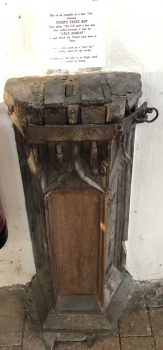
Henry VIII put a stop to that in 1534, and the box here was used as a ‘poor box’ for the locals. I wonder what Henry would have said, had his ‘Chancellor’ been Theresa May, with her telling him that in order to break from Rome, Henry’s ‘divorce bill’ would be something like, oh, 40,000,000 Sovereigns?
So a taste of Suffolk, a delightful county; where else might you meet a tortoise, giraffe, Monopod, Moses and the Devil, all in one afternoon?
Edit: Following Surellin’s comment at 3.15pm 27.02.18, here is a picture of the mill from the side, which might help. I took the name ‘Post mill’ from the English Heritage signage at the site.
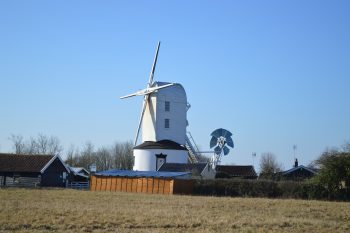




Deep Thought was wrong then.
It was Size 42.
Paul Marks has clearly found his look and should stick with it 😎
You guys must have been not that far from Audley End, described by James I when he visited as “too grand for a king, but might do for a Lord Treasurer”. (He later launched an enquiry into the treasury accounts, which IIRC turned up considerable evidence of peculation.)
You must also have been close to Castle Hedingham. Having visited Framlingham, a castle without a keep, you might enjoy Hedingham’s Keep without a castle. Queen Matilda died there.
That’s the Matilda, who claimed to be queen of England as the wife of Stephen, not to be confused with the rival Matilda who claimed to be queen (regnant) of England because she was daughter of King Henry I. (After Queen-regnant Matilda locked Stephen and his principal supporters up in Oxford after the battle of Lincoln, she figured she had won, forgetting that Queen-wife Matilda was countess of the Honour of Boulogne – which included Kent – in her own right, so had a force of knights to command – and, as it turned out, strong opinions about which Matilda should be called queen.) Also not to be confused with Matilda abbess of Fontevraud, sister-in-law of Queen (regnant) Matilda despite the chronicler Geoffrey of Vigois getting the two mixed up in his record of the latter’s death. Also not to be confused with Matilda abbess of Montivilliers, Queen (regnant) Matlida’s half-sister, with whom she cosigned grants. Also not to be confused with Matilda wife of Brian fitz Count to whose castle Queen (regnant) Matilda escaped after slipping through the enemy lines besieging her in Oxford. Also not to be confused with Matilda daughter of St Margaret, wife of Henry I through whom the Saxon royal line joined the Norman. Also not to be confused with the powerful Matilda, Countess of Canossa, whose writing of two wills, one leaving her extensive imperial fiefs and allodial lands to the papacy and the other leaving them to Queen (regnant) Matilda’s husband …. actually, maybe I’d better stop here.
It seems to have been a popular name with the 12th century upper-crust. 🙂
Moses with horns:
😀
The helmet fitted well enough Perry – but the nose guard did not, perhaps due to my ethnic origins (although I have no horns).
The swords on sale were poor quality – but one can not get even a good Gladius for under 200 hundred Pounds (by good I mean sharp and of proper steel), I considered buying a proper Gladius in January – but bought a new computer instead (and then this one started working again – what a waste of money by me).
I hate what the “reformers” did to the churches – I have no objection to a plain church (it can have a quiet dignity), but to vandalize a church is wicked, and what the “reformers” did to many churches was vandalism. On the other hand I reject the idea that the parish clergy should be unmarried – and I do not want to have to pretend that what Pope Francis says matters (every Anglican knows that the words of Archbishop Welby are to be ignored – we do not pretend to take them seriously). Having annoyed everyone theologically, I will pass on to other matters.
Yes the churches and the wonderful villages are well worth visiting as was the town and castle – you London people have no excuse not to go (as these places are nearer you than they are to me – and Mr Ed has to come from even further away and drive for hours). Consult a map – and then off you go people.
On the Civil War of the early 12th century – I am firmly in the Matilda camp (the one that was the daughter of King Henry the first). Only legitimate child of the previous monarch, a direct descendant (via her mother) of Alfred the Great, and every nobleman had sworn a oath to uphold her claim.
I hope Mr Ed will agree that those who followed Stephen were oath breakers and that Stephen’s claim to the throne had no legal basis.
For those of you who are interested I just finished watching the excellent BBC series “England’s Forgotten Queen: The Life and Death of Lady Jane Grey” by Helen Castor. Of course Framlingham Castle is in many ways the fulcrum around which the whole story revolves. Highly recommended if you like that kind of thing, and available for free on the youtube.
Paul, the photo of you with the helmet on needs to be your portrait from now on.
What Jonathan said^ 😀
JP and Alisa – I have no objection to that, the helmet was quite comfortable and the nose guard could be adjusted to not crush my big nose.
It is often forgotten that the nose (like the ears) grows with age – so people, if you live long enough, you will all be “Jewish”. I did not actually think my nose was big – but the nose guard was a problem.
I have just had an electricity and gas bill that makes the price of a good quality Roman Gladius (like that “Mainz Condor” I lusted after over Christmas and the New Year) look quite inexpensive. I do not understand it – as I do not have central hearing, the gas fire has not worked in years and nor has the fridge.
When I was young (well less old) a man would come round to read he meter – now the company just “estimates” the bill at a zillion-willian Pounds and that is that. No wonder people support Comrade Corbyn and his Red Guards – under socialism there would be no electricity and gas bill, of course there would also be no electricity or gas….
You should also wear it when canvassing, as I think has been suggested by Mr. Ed in his post. This could have a revolutionary effect on the state of UK politics, and possibly beyond.
I really do like proper defenses (dry or wet) BEFORE one gets to a castle wall. If anything the photographs do not do fully justice to Framlingham in this respect.
If one can just walk up to a castle wall and gate and raise a ladder or use a battering ram (as with “Game of Thrones” and so many other shows) then one is dealing with a joke – not a castle.
I remember visiting Caerphilly in Wales (the castle is in the center of town) – at least in my memory the system of water defenses would keep any siege engine well away from the wall (the further away the less impact rocks and even cannon balls will have). Dover castle does this by chalk defenses and height.
Perhaps the strongest fortress of all is India – Jaipur, five hundred feet high (physics helps with the defense) and with walls cut from the living rock that could make even black powder cannons impotent.
I am sure that Mickael Jennings has been to the “Blue City” of Jaipur – as he has been everywhere.
Me too. Bizarrely, Ellis Peters, whose Brother Cadfael books are probably the way most people know anything at all about the period, really has a down on Queen (regnant) Matilda. Why she dislikes her so much I never could fathom. She’s willing to be fair to her partisans but not the lady herself. Odd.
(To be fair, I suppose the way even more people know – or should I say, don’t know – anything about the period is through the dreadful adaptions of those books by the beeb, with their additions of, and revisions into, heavy-handed beeboid-writer sermons about the wicked, prejudiced un-woke past.)
I’m of the opinion that taking sides in the (first) twelfth-century civil war is a bit pointless. Mathilda might have had a bit more right on her side (note though there had never been an unchallenged primogeniture succession in England so her claim was not strong), and Stephen was crowned legitimately, but neither seems to have been a particularly useful leader. Interestingly their brothers and sons (Robert of Gloucester and the rest and Henry; the Count of Blois and Bishop Henry of Winchester and Eustace) seem more competent. Never did figure out how these two claimants became the figurehead when bastards and foreign rulers had taken the throne repeatedly in the last century so more competent figures were hardly excluded.
And considering how the anarchy played out,a lot of contemporary lords agreed with this view…
BTW you must also have been close to the superb mediaeval town of Lavenham. (Town in those days, so it is a large village by today’s standards.)
A letter in today’s DT states that, 55 years ago, Wilfred (later Sir Wilfred) Burns, who worked in Coventry before being appointed chief planning officer for Newcastle, wrote of East Anglia in “New Towns for Old”:
Paul notes that “to vandalize a church is wicked”. Stroll round Lavenham and, quite apart from its church, you may think Sir Wilfred represents an exceptional level of depravity. Fortunately, he was unable to do the evil he meditated in that part of England at least.
Niall,
We have been to Lavenham, but in summer on the way to the Clacton Air Show (now there’s a contrast). Lavenham is best described as a surveyor’s worst (but most beautiful) nightmare, so many timbered houses resting at improbable angles.
Lavenham and nearby Long Melford are both marvellous, the Hyde Parker family’s hall at Long Melford is excellent (one of the Hyde Parker Admirals got the original Nelson’s Eye treatment at Copenhagen). Sadly daytime did not permit this early in the year.
There is also Orford Castle, a keep without walls, perhaps Sir Wilfred would accept transplanting the walls of Framlingham Castle to surround Orford, and make room for a nice multi-storey car park to ease Framlingham’s (non-existent) traffic problems, and then we can hand him over to Old Nick in Wenhaston where he would find that hot coals are not very good suppositories.
Sigh…Mr Ed & The Sage never take me anywhere. So I had to hunt up some photos of Lavenham and surrounding spots of interest:
http://www.picturesofengland.com/England/Suffolk/Lavenham
Mr Ed, thanks for the travelogue, with photos. Very interesting, maybe especially the churches and accoutrements. I’m darned if I can make a giraffe out of that statue, or figurine. It looks to me like something trying to be a gryphon. :>)
I adore the picture of Paul, properly decked out, as you say, to go canvassing. 😎
😀
Caerphilly Castle was the Stealth Bomber of the 13th Century Paul. Nobody in their right minds attacked it after its completion. As you know, I was born there (not the castle of course, but up the hill in Mountain Road). It was my playground as a child and I have loved castles and history ever since.
Thank you all so much for this piece, and the comments. Enjoyed the history lesson (even if it is largely incomprehensible to me).
And in checking out the map of Lavenham it shows those wonderful names of English towns, all sounding like they are straight out of a P.G. Wodehouse story. Shimpling, Nedging Tye, Little Waldingfield, Foxearth; I’d like to visit all of them. Perhaps it’s just a matter of familiarity, but American town names never seem to sound like that.
I worked as an engineer in Kettering for 5 years and in many respects it was the best of England. The Great War dead from Kettering was so great that it is spread around the 4 walls of the public library.
That’s because the US is not really “English”, but a mixture of various heritages, the English one being very important, but by no means the only one. FWIW, I recall somewhere in the early 90s a survey published in the Time magazine, asking Americans about their ancestry. The largest group turned out to trace their origins to Germany.
Same here 🙂
By the way, to our American readers, the area of East Anglia that Mr Ed. and Paul M visited has been home to dozens of US air bases, starting from WW2. A short distance from Blythburgh Church, as shown here, is Leiston, a small settlement from where Chuck Yeager, the fighter pilot and test pilot of legend, once flew. Jimmy Stewart, the actor who left Hollywood to be a bomber pilot, flew from Norfolk in the same region of the UK.
Today, RAF Mildenhall and Lakenheath, near Bury St Edmunds, continue as bases. Others recent Cold War bases are sitting there, gathering moss, although they could be restored to use soon if needed.
On the other hand, you will never (unless you move here) find yourself living in the villages of Ugley or Nastie. You will never have to deny you are snobbish in Upton Snodsbury, nor lazy in Little Snoring, nor will credit checks be made when you tell your bank you are renting in Littleworth but will buy in the nearby village of Begbroke, nor will your friends demand you write in heroic couplets from Rhyme Intrinsica, nor the authorities revoke your 2nd amendment rights back home when you return from Upper Slaughter.
Alisa (February 27, 2018 at 9:01 am), I think it is not the lesser mix of heritages but the greater length of history that causes the names to be worn down from ones that once sounded as ordinary as US ones do today. Over the course of many centuries of gradually-changing pronunciation it is possible that the English sense of humour also played a very occasional role but I think 99% of it is just an accident of time.
Niall, it could be a little bit of both, and possibly more.
Niall,
Little Snoring is far over the border in Norfolk from our sortie, and whilst it is not as pretty as its neighbour Great Snoring, Little Snoring has another splendid Round Tower church of St Andrew.
Fascinating – that windmill isn’t a post mill. That is, the blades are not attached to a vertical post which , rotating, will allow the blades to turn toward the wind no matter its direction. The wind must be VERY constant in direction there. Or maybe I’m missing something.
Surellin,
I have edited the post to add a picture of the mill from the side, which might help. I took the name ‘Post mill’ from the English Heritage signage at the site. The picture should appear from the bottom of the post. The mill seems to face more or less east, about 12 miles from the North Sea.
I got a good chuckle over “Brockley Green”.
I am no expert, but I think the whole top storey rotates around a central post That “tail rotor” assemblly provides the motive power to turn. I think it was almost automatic. If the wind shifted to blow on one side the rotor would spin in whichever direction moved the sail back directly into the wind. May be an analogy there with some politicians automatically spinning, depending on which way the wind blows!
Anyone can be “crowned legitimately” – if by “legitimately” one means by OATH BREAKERS.